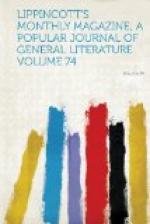The play to be represented was not the “Passion play,” which is given every ten years, but the Kreuzesschule, which is played once in fifty years—last in 1825. In it the play is taken from the Old Testament, and the tableaux from the New Testament—the reverse of the Passion play.
The orchestra began punctually at nine o’clock. There were about twenty performers, and they played with skill and taste. The selection of music was admirable. They commenced with a sort of prelude, slow and declamatory. Perfect silence reigned, and the deep interest of the spectators was, from the first and throughout, shown in their expressive faces. Men and women at times shed tears, and made not the slightest effort to hide their emotion. The black head-kerchiefs of many of the women spectators, tight to the skull with ends hanging down behind, seemed in harmony with the scene.
The prelude ended, the Chorus entered with slow and dignified pace—seven men and women from one side, six from the other, all in a kind of Oriental costume, picturesque and handsome. The tallest came first, and so on in gradation, so that when ranged in front of the curtain they formed a kind of pyramid. The central figure then began the prologue, an explanation. Then the basso commenced singing an air, during which the Chorus divided, falling back to the sides and kneeling, while the curtain rose, displaying the first tableau. This lasted nearly three minutes, during which time the figures were really perfectly motionless. The basso finished his air and the tenor sang another while the curtain was up. This tableau represented the cross supported by an angel, while grouped around were men, women and children looking up at it in adoration. This was the “Kreuzesschule”—the school of the Cross—the prologue to the piece. The picture had the simplicity of the best school: no affected attitudes—all plain, earnest and beautiful. When the curtain fell the Chorus again took their places in front of it, a duet was sung, then a chorus, and then they countermarched and retired in quiet dignity.
Then came the first part. A prelude by the orchestra, and the curtain rises on Abel, dressed in sheep skin, by his altar, from which smoke ascends, he returning thanks. Enter Cain in leopard skin, much disturbed and angry. They discourse, Abel all sweetness, Cain bitter and cross. An angel in blue mantle, like one of Raphael’s in the “Loggia,” appears at the side and comforts Abel. Then Eve in white dress—evidently it had been a puzzle to dress her—and buskins, who says sweet words to Cain. Then Adam in sheep skin, very sad at all this difficulty. Eve sweetly strives to reconcile Cain to his brother, and appeals to him with much feeling. He discourses at length, then appears to relent and embraces Abel, but is evidently playing the hypocrite, and as the curtain falls you see that hate is in his heart.




